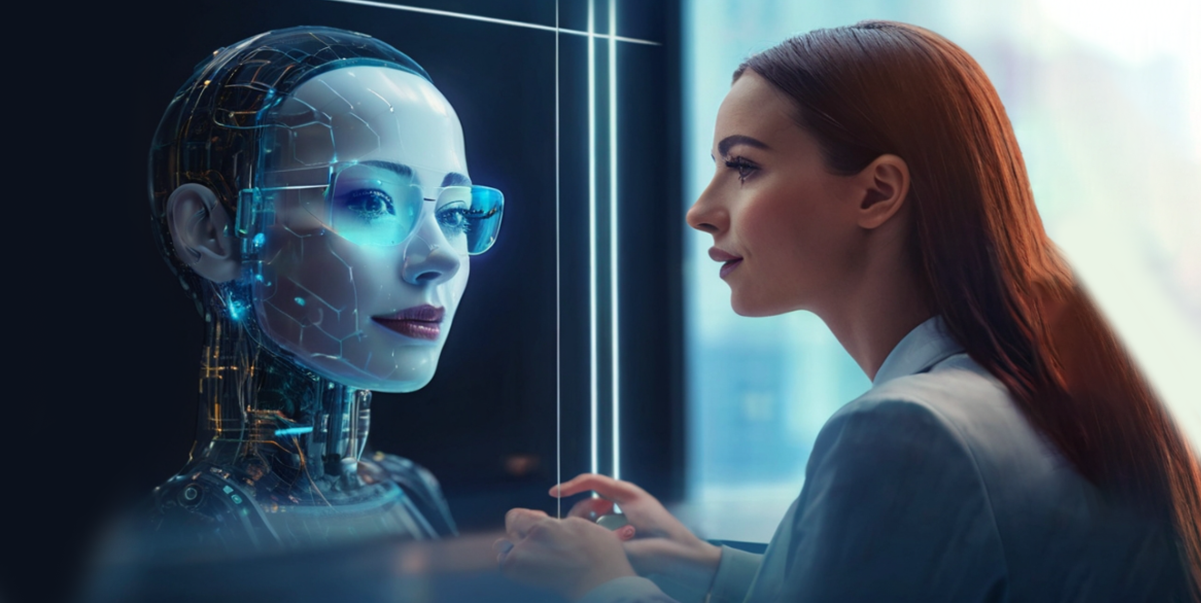ChatGPT-4 The Future of AI Interaction

The new ChatGPT-4 model from OpenAI, which can talk, recognize, and interact with users in real time, is transforming human-AI interaction and the future of education, customer service, and software development.
OpenAI announced an update to GPT, introducing the GPT-4, which can talk and recognize like a human, delivering real-time information. AI can now recognize emotions and enhance authentic conversations and interactions with users. Called GPT-40, the new GPT-4 model is free for all users, enables screen sharing and real-time feedback, and revolutionizes AI communication. AI’s ability to analyze text, audio, and video enhances its conversational capabilities. A.I. The evolution of voice communication and AI shows a huge improvement in communication with technology. A quick technical redefinition emphasizes understanding context and limitations rather than just research papers. Adding a phrase for clarity increases the speed of AI responses, emphasizing the importance of communication skills in human-AI interactions.
The AI generation is evolving to provide real-world, personalized assistance in areas such as training, customer service, law enforcement, and employee education, by reworking the way we analyze and create images on the snow. Customer support and schooling spells can also be real-time emotional intelligence, to enhance one’s experience and engagement according to individual desires. The role of AI in coding assistance and team training through display screen sharing and real-time notes will streamline processes and increase productivity over the period. Integrating AI into manufacturing and change management will provide efficient direction, reduce the need for micromanagement, and reduce boom team productivity.
AI technology has advanced to create interactive AI bots that can help corporations, rework industries and transform human-computer interactions. The strength of AI bots, is to help users in duties and interactions, and to enhance user enjoyment and accessibility. The rise of AI generation that allows dynamic, customized consumer interfaces is converting the way software programs and apps engage with customers. The effect of AI on intake makes the era extra person-pleasant and reachable to greater human beings.
How does the new ChatGPT-4 model differ from the previous version?
The documentation describes a brand new ChatGPT-4 model with the ability to speak, display screen and speak with customers in real time. It can observe textual content, audio and video, responding right away and recognizing feelings within the client’s voice. This new paradigm brings more emotion to conversations, faster responses, and the functionality to apprehend and reply to the man or woman’s emotions. Additionally, ChatGPT-four can system statistics automatically at the individual’s tool, growing pace and responsiveness.
What are the potential implications of AI-powered real-time interaction
on various industries?
The potential implications of AI-powered real-time interaction on various industries are significant. Here are some key points based on the video:
Education and Training: AI can provide real-time feedback and guidance, making onboarding and team training seamless. This can reduce the need for micromanagement and enhance the learning experience for new team members.
Customer Service: AI can offer real-time assistance and guidance, leading to more efficient and personalized customer interactions. This can revolutionize the customer service industry by providing immediate support and empathy.
Software Development: AI can assist in coding and problem-solving in real-time. Developers can receive feedback and guidance while working on projects, leading to faster development cycles and improved efficiency.
Content Creation: AI can guide content creation teams in real-time, providing assistance during the editing process. This can streamline workflows and improve the quality of content produced.
User Experience Design: AI-powered real-time interaction can lead to dynamic user interfaces that adapt to users’ preferences. This personalized experience can enhance user engagement and satisfaction across various platforms and applications.
Overall, AI-powered real-time interaction has the potential to transform industries by improving efficiency, personalization, and user experience.
How can the new features of ChatGPT-4 change the way we learn and upskill?
The new features of ChatGPT-4 can also test the approach we take and increase productivity by providing real-time communication with AI. This enables quality teaching, presentation, and instruction in many areas, including education, technical school instruction, and content development. Users can be 100% exposed and receive immediate and automatic feedback, making onboarding, group schooling, and capacity development seamless and green with benefits What’s more, the ability of AI to recognize emotions and respond with empathy supports learning enjoyment and makes conversations more meaningful and enjoyable overall, ChatGPT-four Skills opens new opportunities for communication skills and talent development, and differentiates between humans and AI is blocked in a dynamic and personal way.
The release of ChatGPT-4 marks a shift in AI technology, opening the door to emotional intelligence and real-time interaction with devices. With AI continuing to evolve, its impact on education, customer service, software system enhancement, and much more will undoubtedly change the course of the industry, bringing new a it’s amazing possibilities for innovation and entrepreneurship to come.
ChatGPT-4 marks a new era in AI communication, where technology and human experiences interact seamlessly to drive growth, redefining the boundaries of what is possible in the digital age Stay tuned for more updates as we explore ChatGPT -4 infinite power and its mutable effects Take body. Let us also examine its effects.














